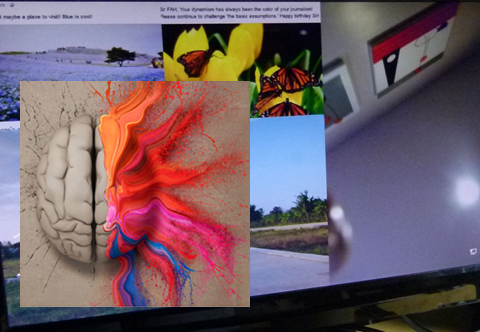I am not in the image above (a Windows 10 collage); I have no car; I have not won in a lottery; I am past retirement age at 79 – and yet:
I must thank God for the blessings that
my digital mind has afforded me.
my digital mind has afforded me.
Blessings?Not money. But of course there is wealth in there – a wealth of creative thinking that age has enhanced much. So now I can think of a new subject faster, grasp what is known better, absorb more and extract more insights, write and blog faster than you can say,
Supercalifragilisticexpialidocious!
I'm exaggerating just a little.
Look, from 01 September 2019 to today, I have blogged (in iParadigm Shifts) 114 thought-provoking, Rip Van Winkle-waking, gender-respecting, mind-changing, highly original, serio-comic essays. These 13 are from September only:
(1) "What is Secretary William Dar Doing Today? Looking At Your Banana!" (01Sept19)
(2) "Paradigms! William Dar Is Waking Up FAO & PH Educators Mesmerized By School Gardens!" (02Sept19)
(3) "New PH DA'S Modernization Paradigm Calls For PhilRice To Grow Up, Not Only Grow Rice!" 03Sept19
(4) "Critics Of William Dar & The New PH Agriculture – How About Some Honesty & Humor!" 03Sept19
(5) "William Dar – The New Moses With The New Tablets!" 04Sept19
(6) "Rice Farming Is A Way Of Life? It Should Be A Way Of Hope!" 05Sept19
(7) "Rice Tariffication – If You Can't Solve A Problem, Change The Problem!" 07Sept19
(8) "PH Rice Crisis – 10 Ways To Discuss? 9 Ways To Disgust!" 08Sept19
(9) "DoST, Together We Can Teach On Terra Firma, Via Outer Space!" 09Sept19
(10) New Paradigm In Rice Farming. Patrick & Rachel Renucci Give Us "SciTech Rice." 10Sept19
(11) "FM & MLQ – About Nationalism & Development, Cup Half-Full & Half-Empty!" 11Sept19
(12) "What The New DA Needs Are Farmers As Partners, Not Protesters And Pessimists!" 14Sept19
(13) "79 at 17 September 2019. Thank You Lord! Reader, Here's My Birthday Gift To You." 17Sept19
Actually, in the last 91 days, I wrote an average of 5 essays every 4 days.
Where do I find the intellectual energy to do all that?
My blogging follows the efforts of Manong Willie
(unofficially) calling for a Renaissance of Philippine Agriculture.
(unofficially) calling for a Renaissance of Philippine Agriculture.
I am Ilocano, but for inspiration & instruction, my universe is English.
So I'm volunteering as a mentor for the youth in the many State Colleges & Universities, SCUs in the Philippines, my Christmas gift to students in those institutions.
Youth, you can learn to write well as I can show you – I am self-taught myself. You will learn practicalcreative writing– no need for a formal course. SCUs, from Mariano Marcos State University in the North to Mindanao State University in the South: I am going to teach you if formally invited by your school. Email frankahilario@gmail.com@517









